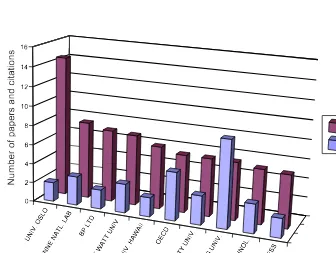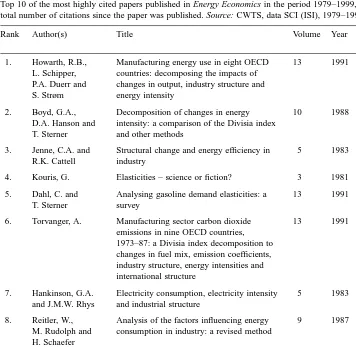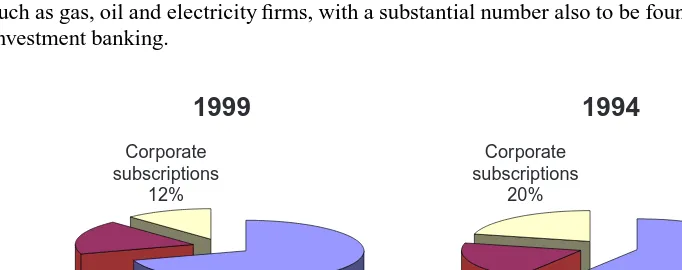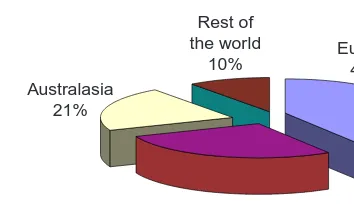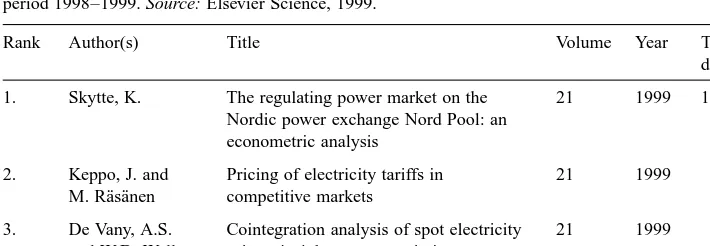www.elsevier.com/locate/ECONbase
Editorial
1. Introduction
As we enter the 21st Century, Energy Economics also celebrates its 21st anniversary. It is a timely moment therefore to publish the first cumulative index of authors and papers which have appeared since volume 1 first started in 1979. We hope that this compilation will be a valuable reference for researchers, professionals, librarians and educators on a topic whose importance in business, economics and politics has become fundamental at this point in history.
The journal is fortunate to have been continuously supported by a number of distinguished researchers since its inception. Morris Adelman, Lars Bergman, John Chesshire, David Hawdon, Robert Kuenne, David Pearce, Robert Pindyck and John Surrey have all served as associate editors since the very beginning, and continue to serve the journal with timely advice and refereeing. We are particularly indebted and grateful for this sustained level of commitment. This group is further enhanced by over 20 more international experts and researchers to comprise a broad and active body of editorial support to the journal. With the publication of this retrospective issue, it is opportune and appropriate to thank these and all the many anonymous referees who have freely contributed their time to ensuring the scientific quality of this publication.
2. Editorial policy
The journal receives over a hundred papers to review each year and eventually publishes, usually after one or two rounds of revision, about a third of the submissions. Numerous referees around the world have supported this process, and the editorial board in particular plays an important role in maintaining the refereeing standards.
The journal has been most inclined to publish papers that are methodologically novel, or provide new and surprising insights into energy-related issues, or provide a rich analysis of an important energy problem that can be useful to other researchers. Papers that just consist, for example, of the routine use of a standard econometric technique to some readily available sets of energy data, are not normally published, unless the results are very surprising. Similarly, commentaries on current issues of energy policy usually need to have some analytical contribution in order to survive the refereeing.
When we look at the topics that comprised the first volume, we see a representation of the issues that were of significant political and economic concern at that time. There were papers on the depletion of exhaustible natural resources, on the economics of nuclear energy, on energy conservation, and on the taxation of oil in the North Sea. Yet by 1999, none of these themes were strongly represented in volume 21. In just 20 years, the agenda has shifted to include competitive electricity markets, SO2auctions, financial markets for energy and regulatory issues. Energy Economics has therefore grown out of its base in macroeconomics and public policy to become immersed in strategic gaming and market mechanisms.
In following such a fast moving subject, this journal has sought to provide more than just a topical reflection on the evolution of these policy concerns. In its early years, under the editorship of Homa Motamen, its aims and scope were stated quite simply as providing “: : : a forum for papers concerned with economic theory, methodology, statistics and mathematical modelling : : : concerned with the economic analysis of energy issues”. A strong methodological theme has always been important, therefore, to papers published in this journal. The latest statement of the aims and scope reinforces this.
“: : :Contributions to this theme [energy systems and issues] can arise from a number of disciplines including economic theory, regulatory economics, statistics, econometrics, operational research and strategic modelling. A wide interpretation of the subject is encouraged to include, for example, issues related to forecasting, financing, pricing, investment, development policy, conservation, regulation and the environment.”
3. Retrospective evaluation
3.1. Subjects
The cumulative Keyword index provides a revealing portrait of the balance of issues and methodologies that have featured in the journal during the past 21 years. Throughout most of the papers, general or specific implications for demand and prices in the energy sector are never far from the central theme. Within the energy sectors, electricity is the most common, with over a hundred keyword listings, very closely followed by oil. This emphasis upon electricity has in fact been increasing in recent years with the worldwide restructuring of this sector raising many new research issues. Gas has 24 keyword listings, coal has 15, nuclear has 14, but renewables are only listed in 3. Strongly featured topics have been Depletion (12), Carbon Emissions (30), OPEC (11) and price=demand elasticities (42). Methodologies such as input-output analysis (18), computable general equilibrium (9), cointegration (8) and decomposition (8) have been popular with the generally strong econometric orientation of the journal.
3.2. Authors
– almost 40% of all authors are US. The North Americans are followed by the UK with 15% of the authors. Significant numbers of published papers have also emanated from Canada (6%), Australia (4%), Sweden (3%), Germany (3%) and Norway (3%). At the same time, by far, most authors of Energy Economics can be found in universities (63%), followed by research institutes (9%), governmental organisations (8%), and 7% work for corporate organisations.
Whilst it is interesting to look at the average impact of the publications by each country, measured by the average number of citations to those publications, this is a measure that often reflects a small denominator. Thus, Singapore comes out top on this measure with the highest average number of citations (4.7%) followed by Sweden (4.6%) and Thailand (4.5%). A closer look at the publishing institutes in those countries shows that all publications from Singapore originate from the National University of Singapore. The majority of publications from Sweden are from Gothenburg University and the University of Stockholm, whilst most of publications from Thailand come from the Asian Institute of Technology. As Fig. 1 shows, the top 3 most highly cited institutes in Energy Economics comprises both a university, a research institute and a corporate institute, the University of Oslo (Norway) being number 1, the Argonne National Laboratories (USA) being number 2 and British Petroleum Ltd. (Great Britain) being number 3.
3.3. Impact
In the period 1979 to 1999, Energy Economics has published 616 articles, 5 editorials, 2 reviews and several other types of publications. A citation study over this period shows an average citation of 1.8 per article, 1.6 per editorial and 3 per review. The average number of citations to articles has been fairly constant from year to year. Around the averages, of course, we see considerable individual variations. The citation count for the articles published about 15 years ago is currently peaking around an average of 4. More recently, volume 13, published in 1991, has also received considerable interest – the average number of citations per article is 2.8. As Table 1 shows, not surprisingly, 3 out of
Table 1
Top 10 of the most highly cited papers published in Energy Economics in the period 1979–1999, ranked by total number of citations since the paper was published. Source: CWTS, data SCI (ISI), 1979–1999.
Rank Author(s) Title Volume Year Total
citations 1. Howarth, R.B.,
L. Schipper, P.A. Duerr and S. Strøm
Manufacturing energy use in eight OECD countries: decomposing the impacts of changes in output, industry structure and energy intensity
13 1991 28
2. Boyd, G.A., D.A. Hanson and T. Sterner
Decomposition of changes in energy intensity: a comparison of the Divisia index and other methods
10 1988 23
3. Jenne, C.A. and R.K. Cattell
Structural change and energy efficiency in industry
5 1983 21
4. Kouris, G. Elasticities – science or fiction? 3 1981 19 5. Dahl, C. and
T. Sterner
Analysing gasoline demand elasticities: a survey
13 1991 19
6. Torvanger, A. Manufacturing sector carbon dioxide emissions in nine OECD countries, 1973–87: a Divisia index decomposition to changes in fuel mix, emission coefficients, industry structure, energy intensities and international structure
Analysis of the factors influencing energy consumption in industry: a revised method
9 1987 15
9. Li, J.-W., R.M. Shrestha and W.K. Foell
Structural change and energy use: the case of the manufacturing sector in Taiwan
12 1990 15
the top 10 most highly cited articles were published in volume 13. Among these articles is the number 1 most highly cited paper by R.B. Howarth, L. Schipper, P.A. Duerr and S. Strøm. The last few years have lower counts because of the time-accumulative nature of this measure. The average impact factors are based on the impact factors as published by the Social Science Citation Index.
4. Readership
Readership of Energy Economics is strongly represented amongst academic re-searchers. In 1999, 70% of the institutional subscriptions came from academic in-stitutions, 12% came from corporate institutions and 18% came from governmental institutions (Fig. 2). There has been an upward trend to academic readership over recent years – in 1994, the figure was 59% of all institutional subscriptions coming from academic institutions. However, in contradiction to what one might expect from the shift to competitive energy markets and the corporatisation of the energy sector, the rate of corporate subscriptions has been decreasing – in 1994, 20% were coming from corporate institutions. At that time, 21% of the institutional subscriptions were coming from governmental institutions (Fig. 3).
Energy Economics has a balanced world-wide coverage. Most subscribers are Euro-pean (41%), followed by North American (28%) and Australasian (21%), leaving 10% for the regions in the rest of the world. Growth in subscriptions is now coming from Asia and the Middle East (Fig. 4).
The number of academic subscribers in North America is relatively higher than in Europe. In Europe, interestingly, Energy Economics has relatively more corporate and governmental subscribers than in North America, but academic subscribers still form the majority. Corporate subscribers are mainly public and private energy corporations, such as gas, oil and electricity firms, with a substantial number also to be found amongst investment banking.
Corporate subscriptions
12%
Corporate subscriptions
20%
Governmental subscriptions
18%
Governmental subscriptions
21% Academic
subscriptions 70%
Academic subscriptions
59%
1999
1994
Rest of the world
10% Europe41%
North America 28% Australasia
21%
Fig. 4. Readership of Energy Economics by region, 1999. Source: Elsevier Science, 1999.
5. Electronic presence
5.1. Extended visibility and availability
Energy Economics has had its own web page since 1998, which can be visited at http://www.elsevier.nl/homepage/sae/econbase/eneeco/menu.sht. The electronic pres-ence is an extra service to authors in order to encourage wider readership. Also, it offers added value to readers to search and access all papers in the journal. The information on the web page encompasses:
žComplete papers online žAbstracts Archive žKeyword index žAuthor index
žSubscription information žSample copy
žDispatch dates žAims and Scope žEditorial Board žInstructions to authors žArticle Status Information
5.2. Electronic usage
The archive of complete papers online is freely accessible to all readers with an institutional subscription to the print journal. It includes papers as from January 1998 (issue 20.1) and onwards. Full papers can be accessed since June 1999. In the first months of online full text availability, the number of articles downloaded increased from 96 in June to 497 in November. For a first period, these numbers are, according to the publisher, relatively very high. The three most downloaded papers in the period June–November 1999 are presented in Table 2.
Table 2
Top 3 most downloaded papers in the period June–November 1999, published in Energy Economics in the period 1998–1999. Source: Elsevier Science, 1999.
Rank Author(s) Title Volume Year Total
downloads 1. Skytte, K. The regulating power market on the
Nordic power exchange Nord Pool: an econometric analysis
21 1999 105
2. Keppo, J. and M. Ra¨sa¨nen
Pricing of electricity tariffs in competitive markets
21 1999 76
3. De Vany, A.S. and W.D. Walls
Cointegration analysis of spot electricity prices: insights on transmission efficiency in the western US
21 1999 63
number of requests for abstracts has been steadily increasing and now has an average of more than 180 requests per month in 1999.
5.3. ECONbase
Energy Economics’ web site is included in ECONbase, a searchable database covering:
ž65 journals in economics, econometrics and finance ž13,500 searchable abstracts
ž3,400 online papers
ECONbase is updated each month with some 200 new abstracts and articles. All information within ECONbase is in the public domain, except for the complete papers online per individual journal. Complete papers are available for readers with an institutional subscription to the print journal. Functions such as searching through titles, authors, abstracts, JEL classifications and key words or retrieving abstracts of all journals are free. For the public section no registration is needed.
Per October 1999, ECONbase is visited by some 25,000 active distinct hosts each month. Each month some 40,000 abstracts and on average 25,000 complete papers are downloaded.
5.4. Contents Alert Economics
6. Looking forward
Since 1997, Energy Economics has grown out of its original quarterly schedule and now appears six times a year. It has been attracting an increasing flow of acceptable papers and we expect its page extent to grow even more in the next few years. Currently, it is operating with a six-month backlog of accepted papers awaiting actual publication. To the extent that the journal grows, we will maintain a policy of expanding pages to ensure that the backlog will not get any longer.
Special issues have not featured strongly in the journal’s history. Only two special issues have appeared and even these are very recent. Energy-Environment Modelling, edited by, D.W. Bunn, E. Larsen and K. Vlahos was published in 1997, and The Optimal Timing of Climate Change Policies, edited by C. Carraro and J.-C. Hourcade, appeared in 1998. The second has excited considerable interest in the research community and we expect it to be heavily cited in the future. We would like to feature more timely special issues and we will encourage and welcome interesting proposals for this over the next few years.
The strength of this journal is in its balance of applied inspiration and methodolog-ical rigour. As a subject area, energy economics promises to be even more relevant in the next 21 years as the global challenges of energy, environment, business and economic development become more interwoven, and as technology and market-based solutions make their resolution more sophisticated. Energy Economics will continue to provide an important outlet for topical analyses and with its mission to respond to new methodologies, offer leading-edge insights accessible to professional readers as well as university-based researchers.
DEREKW. BUNN
